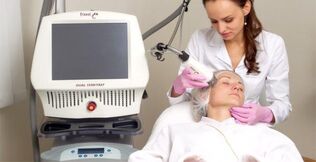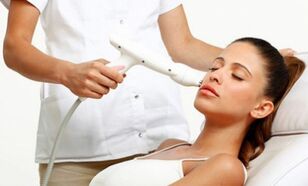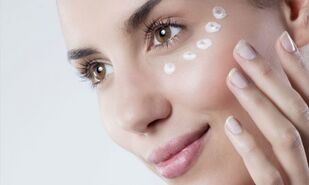Aging is a natural biological process that affects all the tissues of the human body, including those that make up a person's outer appearance. At the same time, facial tissues are more susceptible to aging than others. Occur because they are constantly under the influence of environmental factors, chewing, copulation and speech functions. Since the face is a person's "visiting card", the issue of preserving and restoring the youthfulness of the facial skin is particularly important andRelevant. Among the many methods and techniques used today to solve this problem, laser facial rejuvenation deserves special attention.
The essence of this method is the partial effect of a laser beam on the skin. The laser stream is divided into several thinnest beams, which affect the microscopic areas of the skin, located at a strictly specified depth, andEvaporates them. The intact cells located between these regions stimulate the active production of collagen and elastin - the two main "building materials" that form less and less in the human body with age. After this process, the skinThe color improves, small and medium wrinkles are corrected, bags are removed under the eyes and the oval of the face is tightened. At the same time, the rehabilitation period is minimized. Use of partial laser rejuvenationNot only can it be done as an independent method, but also to improve plastic surgery or laser skin resuscitation results.

Partial laser used for rejuvenation laser
For the first time in the world, a patent for the theory of fractional laser exposure was obtained in 2004 by the American company Palomar Medical Technologies. Fractional laser systems are currently offered by a wide variety of laser technology companies. The most widespread areLaser systems from Palomar and Fraxel, confirmation of lasers from the well-known American company Synthen, Gentle YAG lasers from Candela and others. Since all of these approaches have a general principle of action, the result of the process is largely the professionalism of the expert conducting the process. Is determined by
differences for laser rejuvenation process
There are complete differences to the process:
- pregnancy, lactation.
- Foci of inflammatory process in the affected area.
- Psoriasis and Dermatoses.
- Herpes infection foci in the affected area.
- A chemical peel of a treatment area made less than two weeks before the procedure.
- oncological disease.
- systemic diseases of the blood, immune system, connective tissue.
- diabetes mellitus in the stage of decompensation.
- hypertension and severe forms of coronary heart disease.
- Varicose veins in the process area.
- tendency to make keloid scars.
- Family history of vitiligo.
Relative differences include active sun exposure in the last three weeks before the procedure, that is, fresh sunburn in the treatment area less than three weeks before the procedure, as well as superficial and midline peels.
benefits of partial laser rejuvenation
Thanks to the point effect, skin damage is minimal, so that all scars disappear within 3-4 days after the procedure.
This method allows you to treat large areas of skin in a process while maintaining and activating the regenerative processing of the skin, which ensures quick rehabilitation and long-term growth of positive effects.
Theprocedure does not require anesthesia, it can be performed in the neck, dicolate and eye area.
Side effects are rare. Possible complications include temporary form of red-purple spots in the treatment area, mild and rapid passing itching, activation of herpes infection, changes in skin texture, burns, peeling, and crusting. Skin scarring, hyper- and hypopigmentation in the process area are extremely rare, but can be permanent.
what is a complete course of laser rejuvenation procedures
A session of partial laser exposure lasts 20–40 minutes, depending on the nature of the problem and the area treated. Repeated procedures are performed in 3-4 weeks. As a rule, a total of 3-4 sessions are required. After the final procedure the maximum positive effect is within three months. It is recommended to have a maintenance session once every 10-14 months.

what to do after laser facial rejuvenation process
Mild irritation disappearing 1-2 hours after the procedure, while redness and mild swelling may persist for 1–3 days. During this period, external agents (creams, ointments, sprays) containing dexpanthanol were used. Should go, for example, bapenten, panthenol, d-panthenol. Before the disappearance of listed symptoms and the next procedure, a cream with hyaluronic acid is applied.
You can take a shower and wash on the day of the procedure, but it is better to wait with a sauna and pool. Foundation can be used the day after the procedure.
It is mandatory to use sunscreen with a safety factor of at least 30, as skin metabolism is activated at this time, and it becomes particularly sensitive to sun rays.
Following the procedure, it is necessary to follow the recommendations of the expert who performed the procedure. The choice of cosmetic products, frequency and duration of their use is determined individually and depends on the skin type and its characteristics.
Partial laser rejuvenation is a cosmetological process during which the skin is exposed to a laser array made of microbiomes. The intent is to activate regeneration processes and collagenogenesis. This relatively new, but already very popular hardware techniqueSecondly, it is called fractal, fractional laser resurfacing or photothermolysis.
Principle of operation and varieties of partial laser rejuvenation
How does a fractional laser work? Micro-rays emitted by the system cause heat shock, in response to which "lazy" skin cells begin to function more actively. To repair the damaged area, they rapidly divide. Old cells that became dormantAre giving way to young people. The heating of the deeper layers of the skin is accompanied by the partial denaturation of proteins, as well as the formation of new components of the extracellular matrix, including elastinals and collagen.
According to the depth of effect, ablative and non-ablative laser rejuvenation is distinguished. The first is superficial and resembles grinding. Laser treatment of the upper layers of the skin is accompanied by evaporation of moisture, which damages the epidermis. After treatment, the skin becomes more toned, its relief and color leveling. During non-ablative photothermolysis, the laser acts on the deeper layers of the skin. In this case, no open wounds are formed.
Each type of rejuvenation has its own benefits and minutes. Thus, the effect of ablative laser resurfacing after the first procedure is noticeable. By this method, you can get deep wrinkles and age spots, acne, stretch marks, scars. With the non-ablative process, there is no risk of infection, and the anti-aging effect is noticeable for many years. For individuals under 40 years old with the first signs of aging thisThe type of photothermolysis is recommended: fine wrinkles, shrinkage.
signs and differences for the process
If available, photothermolysis procedure can be resorted to:
- dysfunction, skin dysfunction.
- both fine and deep wrinkles, crow's feet.
- pigmentation of any origin.
- Increased secretion of sebum.
- Increased perforation, risk of acne.
- scars, stretch marks, after acne.
- Vascular "stars" (kuposis).
- dull color.
The differences for partial laser rejuvenation are:
- allergy, psoriasis.
- Autoimmune diseases.
- pregnancy, breastfeeding.
- Blood disease.
- skin infection, swelling in the area of intended treatment.
- Any chronic disease in the stage of discontinuation.
- oncology.
- Increased body temperature.
- diabetes mellitus.
- tendency to make keloid scars.
- Epilepsy.
Features of Laser Rejuvenation
Preparation of the fractional photothermolysis process involves going to the solarium for two weeks and refusing to go to the beach. It is also impossible to clean the skin all the time, remove chemical peels, sulfonamides, fluoroquinolones, tetracycline. Three days before, they stop going to the pool, bathrooms, sauna, treat the area of perceived contact with alcoholic cosmetics. To prevent complications, cosmetologists may prescribe antiviral and antibacterial drugs for this period. Should be spent without alcohol and cigarettes the day before the procedure, avoid going to the gym.
Before laser treatment, the skin is cleaned with cosmetics and impurities. In general, the effect of the laser is felt as an unpleasant tingling sensation, but sometimes pain relief is needed. In this case, the beautician applies an anesthetic to the prepared skin area. After we work, he proceeds to treat the skin with a laser. The duration of the procedure depends on the extent of the treatment area. And lasts from several minutes to an hour. Finally, the skin is soaked with a nourishing cream.
After the first days of the procedure, you should not use alcohol-based products, compressing the parts of the body where photothermolysis was performed, with compression linen. To exclude physical activity for a week, pool. It is advisable to go, sauna or bath, limit the time spent on the road. The skin is moisturized three times a day with a special cream. And so for half a month. It is undesirable to peel. Use cosmetics with retinol, salicylic acid. It is necessary to use a cream with a sun protection factor of 35 or more for two months.
How many processes do you need to get results? What effect can you expect?
The rehabilitation period lasts 3 to 7 days after laser partial rejuvenation. The speed of recovery depends a lot on lifestyle. Alcohol intake, smoking, excessive activity, unbalanced diet, insomnia and anxiety - all these regeneration processes. Can slow down.
Skin redness and mild swelling may occur for the first three days after laser exposure. Anesthetics and skin cooling can reduce the feeling of discomfort. It is common if skin tightness is felt within a week. , Then there are flaky areas. A side effect of the process may be the bronze tan, which goes away on its own after half a month.
Continuous results after fractional photothermolysis after 2–5 procedures. More specifically, the number of sessions can be determined by only one cosmetologist based on preliminary data. The interval between procedures is 3-4 weeks. As a result of fractional laser rejuvenation, aging processes are interrupted: wrinkles disappear or become less noticeable, ice increases, the severity of pores decreases, and color improves. An effective tool in the fight against scars, pigmentation, post-acne, stretch marks.
Laser fractional rejuvenation is one of the three most popular hardware cosmetic procedures. Its advantages include efficiency, short healing duration, physiology. The result appears after the first procedure and lasts for three years. There is a wide range. It is possible to choose the depth of laser exposure.
Women of any age want to see beautiful skin in the mirror, but not everyone is ready to go under the plastic surgeon's knife.
In this case, partial rejuvenation will come to the rescue through the use of a laser, which takes one of the first places in anti-aging procedures in modern cosmetology.
Types and methods of exposure
ablative photothermolysis
There are two methods of each photothermolysis suitable for individual cases. The right choice in favor of the best option will help the cosmetologist make the first appointment.
This method is suitable for rejuvenating skin that has just begun to undergo natural aging.
The laser-assisted microadam network affects only the upper layers of the epidermis, causing it to regenerate in a short period of time.
The result is visible after the first procedure, as soon as the wound heals.
non-ablative photothermolysis
This method is a slightly more serious intervention. The laser beam penetrates into the deeper layers of the epidermis, ignoring the cells outside.
loss also promotes the production of elastin and collagen, as in ablative photothermolysis.
The treatment process takes longer and the effect is more pronounced. Suitable to overcome severe facial problems.
reading
Anyone who wants to rejuvenate without serious braces can use this method.
Partial laser treatment fights many imperfections on the face, including:
- Very clear wrinkles on forehead;
- nasolabial folds;
- The thread of the crow's feet around the eyes;
- epidermis "flowing";
- skin pigmentation, scars, scars, spider veins;
- Problem of enlarged pores, acne.
Laser therapy has been shown to be highly effective in eliminating all these problems.
The only caveat is that depending on the severity of the imperfection, multiple procedures may be required.
Paradox
Like any other external effect on the body, fractional laser rejuvenation has its own contraindications, in whose presence it is forbidden to resort to such a procedure.
Includes:
- presence of severe swelling on face;
- infectious, fungal skin lesions;
- diseases of epidermis - psoriasis, eczema;
- excessive dryness of skin;
- malignant neoplasm in the body;
- history of epilepsy;
- heart disease;
- Varicose veins on face;
- herpes zoster;
- pregnancy, breastfeeding;
- immunodeficiency states;
- bronchial asthma, severe allergic reactions;
- neurological disease.
All contraindications are conditional, that is, the cosmetologist weighs all the patient's risks.
Sometimes you should first get treatment for skin problems or wait for the prevention of chronic diseases, after which rejuvenation is done.
preparation
Since the intervention is not a surgical operation, no serious preparations are required. Initially, you should consult a cosmetologist who will assess the condition of the skin, and also make recommendations on the required method of photoremediation.
The patient is obliged to tell the doctor about all the conditions and diseases in history, as well as chronic diseases in the last six months.
If any, the specialist will advise you to visit specialized doctors to assess the safety of the procedure.
You should also take a blood and urine test to identify or exclude inflammatory processes in the body. The date of the first visit is determined.
execute
Partial laser skin rejuvenation in the facial area is performed on a patient basis, that is, the patient comes in, is treated, and then goes home.

Beforehand, the cosmetologist would apply an anesthetic cream or ointment based on lidocaine to the epidermis.
In fact, the process is not overly painful, so therapy is sometimes done without going through this phase.
Be aware that the use of local anesthetics prevents the natural regeneration of the skin a little later.
The patient then lies on the couch, and the specialist adjusts the penetration depth of the laser beam on a special device. The device is targeted to certain areas of the epidermis, into which the laser penetrates.
Manipulations last for half an hour and more depending on the area treated with the device. During the procedure, the patient may experience a mild tingling, as well as an unpleasant odor.
Immediately after the session, a grid of red dots appears on the face, the skin is red, slightly swollen, so it is better to take care of how to return home in advance.
Possible complications
Partial rejuvenation does not exclude complications. In some cases, they are normal and go away within a few days.
Others develop due to inexperience of cosmetologists or lack of proper facial care during the rehabilitation period.
what is not standard:
- severe pain or swelling at the site of contact with the laser beam;
- Wounds do not heal in two weeks;
- Pigmentation and scars appeared.
Mild redness, scaling, and itching are a predictable condition for any type of epidermis.
Such results go away automatically within 1-2 weeks, without any visible flaws.
rehabilitation
The result of theprocess itself is strongly influenced by the behavior of the patient. He should carefully monitor the skin, protect it from aggressive environmental effects, and do not apply decorative cosmetics during treatment.

General Guidelines:
- The first three days of the wound should be lubricated with dexpanthenol ointment; This will contribute to early treatment of microdamages. Subsequently, it is recommended to use a mild moisturizer with hyaluronic acid, which was recommended by a beautician.
- Washing is not prohibited.For 2 weeks, the epidermis should not be exposed to strong heat, so it is better to avoid bathing and sauna, do not take a hot bath.
- You should not go out without sunscreen,and it is better to choose protection from 50. If this is not done, then hyperpigmentation will appear. The cosmetic product should be applied until full therapy, even if it is a cold outside.
After a few weeks, it is recommended to visit a specialist who has undergone fractional laser rejuvenation. He should assess the skin condition on the face, excluding complications.
forecast
The result can be seen immediately after treatment, if the imperfections were not very clear. Many treatments have to remove deep wrinkles or scars.
Visually, the skin is smooth, has a natural complexion, the face is hard and visible in 99% of cases.
One percent is devoted to unforeseen circumstances, improper care and lack of qualifications from a doctor.
method benefits
For many patients, this method wins with significant benefits that are worth noting. By selecting photothermolysis, a person achieves the following:
- low cost with high efficiency;
- painlessness;
- also effects from a process;
- non-invasive;
- Lack of strong side effects.
Furthermore, the laser's effect solves many problems of the aesthetic component of the epidermis at once, which is good news.
loss
If you choose the wrong clinic for rejuvenation or do not strictly follow the recommendations of cosmetologists, you can earn older age spots on half of the face, which will not be easy to remove.
Furthermore, laser treatment lasts for a fairly long period of time, during which the patient feels an unpleasant smell of damaged skin, which not everyone is able to withstand.
Another disadvantage is incomplete results from a procedure with deep depression, scars, and wrinkles.
opinion review
Partial rejuvenation is gaining popularity in cosmetology. Every year more and more women choose lasers instead of surgical scalpels.














































































